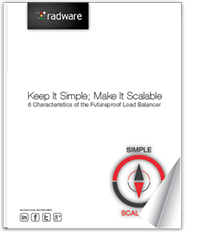Load Balancers and Elastic Licensing
Last week I met with a very large enterprise in finance that has adopted provisioning on demand. They spin up applications on demand, having virtualized most of their infrastructure and have developed tools to automate the provisioning of applications and servers for customers and internal application developers through self-service applications.
Rather than build-out and manage more physical infrastructure, many large enterprises and service providers are moving to software-defined data center (SDDC) that builds on virtualization to offer software and network services to customers – both internal and external.

Increasingly, application teams in many of these organizations are also adopting DevOps practices, new delivery models and architectures that include containers, micro-services and automation to keep up with the demands for continuous delivery and deployment of applications.
IT administrators are using the virtualized infrastructure to realize the cost benefits from industry-standard software and hardware that require fewer network-engineering personnel to manage. A new challenge for the IT team is to adapt to and evolve with demands of continuous delivery of applications. In particular, the IT teams have to enable micro-service applications that are secure and scalable while reducing the costs of deployment.
[You might also like: Load Balancers and Microservices]
So many models but still complex and unpredictable
One of the concerns I hear often is that the vendor licensing models do not support the cloud transitions for the enterprise or applicable to the pooled infrastructure in an SDDC. Of course, there are many models to choose from – perpetual pricing per instance, bring-your-own license (BYOL), pay-as-you-go (PAYG), service provider-licensing agreements (SPLA), licensing by CPU cores, per-user, by throughput, metered pricing based on consumption etc.
The biggest concern is the complexity in licensing for an on-demand provisioning of capacity in an SDDC environment. The performance profile or the capacity constraints for a particular instance may need to change to accommodate traffic profile. The licensing infrastructure and automation needs to accommodate this in an SDDC environment.
[You might also like: Single Sign-On (SSO) for Cloud and On Premise Apps]
Another concern is the additional cost associated with licensing during the cloud transition. Today, an organization has to pay twice for the capacity, one for the physical data centers and then again for the new capacity in the cloud.
An additional concern is for cost predictability and capacity planning. One of our large customers moved some of the larger applications in-house from the public cloud due to the spike and variability in costs with metered pricing and PAYG model.
Conclusion
As enterprises and service providers embark on the SDDC transition, they would like to have a simpler licensing model and infrastructure that eliminates planning risk, enables predictable costs, simplifies and automates licensing for provisioned capacity and enabled the ability to transfer capacity from existing physical deployment to cloud to realize savings.
For more details:
Alteon Global Elastic Licensing: https://www.radware.com/products/alteon-gel
Automation and Orchestration: https://www.radware.com/products/vdirect/
Application Delivery Products: https://www.radware.com/products/alteon/




